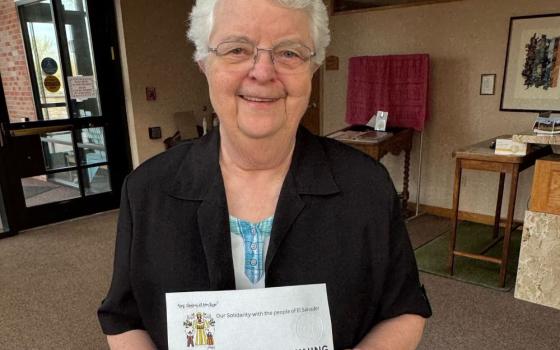The latest Vatican attempt at damage control and image recovery is really an example of history revision. The Vatican has posted to its Web site a short explanation of the 2001 motu proprio, Sacramentorum sancitatis tutela. This decree was not hidden in official secrecy and is fairly well-known throughout the world. The short article provided a summary of the main action steps for cases of sexual abuse of minors by clerics. That offered nothing new. A real surprise, though, is found in one sentence: “Civil law concerning reporting of crimes to the appropriate authorities should always be followed.”
This is the first time the Vatican has publicly agreed that sexual abuse of minors is not only a crime in the secular world, but one that should be reported to civil authorities.
The scandal that has been swirling around the institutional church for decades has been caused by the fact that bishops consistently did precisely the opposite of what the Vatican now presents as standard operating procedure. In spite of the hierarchy’s efforts to first control and failing that, to contain the problem, it has finally reached the Vatican. This has sent shock waves through the ranks of the faithful including the hierarchy’s staunch defenders. They are disturbed and even enraged, not by the unfolding evidence that the pope and the Vatican bureaucrats have been directly connected to the horrendous plague of child molestation, but because the victims and their supporters, aided by the “Catholic bashing media”, have had the audacity to attack the Holy Father.
The Vatican denizens, the curial bureaucrats who actually run the institutional church, are understandably on the defensive and not doing such a great job at it. If the statement about reporting to civil authorities had been left alone and not commented on by anyone speaking for the Vatican, the damage caused by the document would have been minimal. Rather than stay quiet they came to the pope’s defense using the tried but not so true approach of revising history.
Nicole Winfield of The Associated Press reported that the “Vatican has insisted that it has long been the Catholic church’s policy for bishops, like all citizens, to obey civil laws.” Jeff Lena, the Vatican’s U.S. lawyer “has argued that there was nothing in canon law that ... precluded reporting.” He also made a vague reference to the Vatican II document Gaudium et Spes, which he claimed contains an “implicit understanding of the need to follow civil laws.” A Vatican spokesman, Fr. Ciro Benedettini said that a reporting requirement had been an internal policy of the Congregation for the Doctrine of the Faith since 2003, a fact that he would have been better advised to keep to himself. If this policy has been buried in deep secrecy, what good is it?”
The Vatican and its defenders have short memories. In the aftermath of the January 2002 tsunami that hit Boston the very issue of reporting molesters to civil authorities quickly became prominent. The secular community couldn’t comprehend why suspected felons were not turned over to police or reports made to Child Welfare services. Some members of the hierarchy on the other hand couldn’t comprehend why anyone would have the audacity to demand that they should be turned over to the authorities. The resistance was supported by several very prominent ecclesiastics who pontificated to the world media. Apparently they didn’t get the word about the long-standing policy that urged reporting.
Cardinal Oscar Maradiaga of Honduras, who accused the U.S. attorneys who deposed Cardinal Bernard Law of using “Stalinist” tactics, said that clerics who have committed grave errors should be brought to justice by church tribunals. Revisionist history point one: raping children is an error, not a crime and the church tribunals, traditionally noted for slow non-functionality when it comes to due process, are the path to certain justice. Fr. Gianfranco Ghirlanda, an influential canon lawyer from the Gregorian University in Rome, published an article in 2002 replete with Vatican conventional wisdom. He said that civil authorities should be involved only after all church-based remedies have proven useless. He went on to assert that bishops are neither morally or judicially responsible for the acts of their clergy. He continued with the outrageous statement that a priest’s past acts of abuse should not be revealed to his congregation because he would be “totally discredited in front of his parochial community.”
Cardinal Julian Herrenz, retired head of the Pontifical Commission for Legislative Texts, expressed some equally surprising opinions in an article published by John Allen in 2002. Presuming expertise in the field of behavioral science, he stated that pedophilia is a form of homosexuality. Stepping back into his role as a world-class legal expert, he rejected the idea that church authorities be requested, much less required to report abuse cases to civil law enforcement. His justification appears to have been the safeguarding of the “rapport of trust and secrecy” between bishop and priest.
Cardinal Tarcisio Bertone, now the Vatican secretary of state, was secretary at the Congregation for the Doctrine of the Faith in 2002 when he was quoted by John Allen as saying “In my opinion, the demand that a bishop be obligated to contact the police in order to denounce a priest who has admitted the offense of pedophilia is unfounded.” He went on to say that “...civil society must also respect the professional secrecy of priests, as it respects the professional secrecy of other categories.” There is nowhere in Catholic tradition, dogma or law where one can find any justification that supports this opinion.
In practice the policy has been to avoid contact with civil authorities and to cover up the crimes and the criminals. The newly created canonical tradition of referral to civil authorities is the result of one thing: the public outrage, the exposure from the media and the pressure for accountability in the civil courts. The appearance of the “Guide to Understanding” is a failed attempt at damage control through revision of history. It won’t work. The Vatican will never be able to “fix” the problem of clergy sexual abuse because the abuse is not the essential problem that needs fixing. It is the entire clerical culture that needs to be revamped from the inside out.
[Tom Doyle is a priest, canon lawyer, addictions therapist and long-time supporter of justice and compassion for clergy sex abuse victims.]



